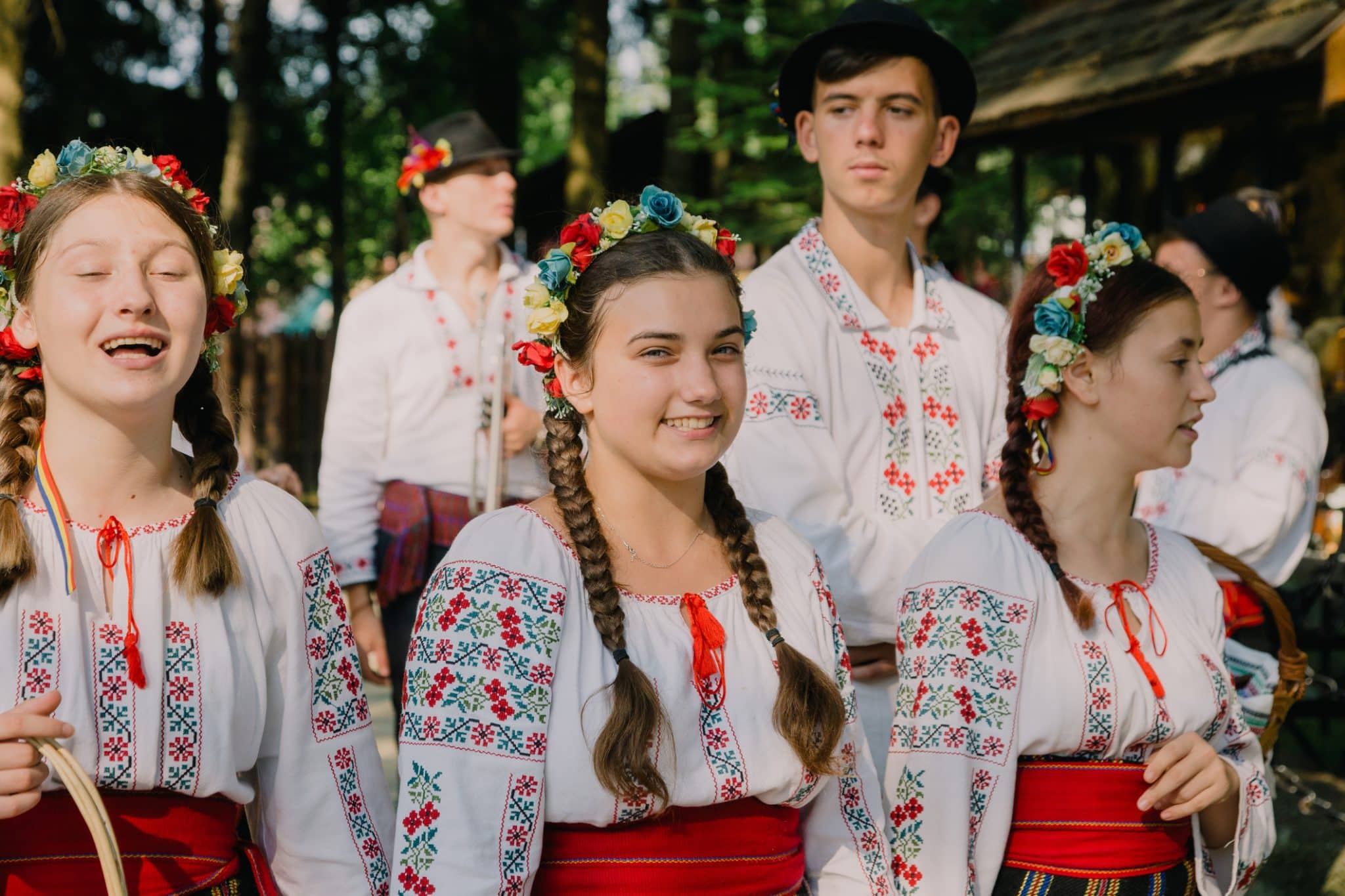The Talking Phrasebook Series presents useful phrases and words in side-by-side translation and with audio files specifically geared to help students work on listening skills and pronunciation. Each entry below, divided by category, features an English word or phrase in the left column and its Polish translation in the right.
In the center column for each row is a play button. The recorded file will feature first English, then the Polish in three versions: one slow, one with each syllable broken out, and a last version that will be spoken as it might be overheard in a conversation between native speakers.
Briefly About the Polish Language
Polish is the official language of Poland and is spoken by approximately 40 million people worldwide. There are also large Polish communities in the United States, Canada, the United Kingdom, Germany, France, and Australia. These communities, especially in large cities, work to maintain their Polish language and cultural traditions, contributing to the global presence of the Polish language.
Polish belongs to the West Slavic branch of the Indo-European language family and is closely related to other Slavic languages like Czech, Slovak, and Ukrainian. Polish has a complex and rich linguistic history influenced by various factors.
In the early medieval period, Old Polish emerged as a distinct language from the various older Slavic tribes inhabiting the region. Polish vocabulary has its roots there but also incorporates loanwords from various sources. Latin, especially during the period of Poland’s cultural and intellectual ties with the Catholic Church, significantly influenced scientific, legal, and religious terminology. Additionally, German, French, English, and Russian loanwords have been absorbed into the Polish lexicon due to historical, political, and cultural interactions.
About Polish Grammar
Polish has a complex grammatical structure, characterized by declension and conjugation. It is a highly inflected language, meaning that words change their forms to indicate case, gender, number, and tense. Nouns have seven cases, and adjectives, pronouns, and numerals agree with the noun they modify. Verbs have complex conjugation patterns, including aspects (perfective and imperfective) and moods (indicative, imperative, conditional, etc.).
Gender: Polish is a highly gendered language with multiple pronouns based on number, gender, and level of formality. Most of the examples in this resource give one (clearly marked) example of a phrase using a specific form of “you.” However, these can generally be modified by replacing the form of “you” used.
Below, we list all “you” forms in Polish. Note that these are genitive forms – which are the forms that would be most used in the phrases given below:
| You | Się/siebie (singular, informal, reflexive) |
| You | Cię/Ciebie (singular, informal) |
| You | Was (informal, plural) |
| You | Pan (formal, singular, male)(like “Sir”) |
| You | Pani (formal, singular, female)(like “Madam”) |
| You | Państwo (formal, plural) |
Verb Conjugation: Verbs are also conjugated based on number and formality. So, examples below may also need the verb replaced. For instance, “Do you?” can you appear in the following forms:
| Do you (speak?) | Czy (mówisz) (singular, informal) |
| Do you (speak?) | Czy (mówicie) (informal, plural) |
| Do you (speak?) | Czy mówi (formal, singular, male or female) |
| Do you (speak?) | Czy mówią (formal, plural) |
Asking Questions: Meanwhile, “Can you” can be said in the following ways: (note that Czy is a word that indicates what will follow will be a question).
| Can you | Czy możesz? (sing. informal) |
| Can you | Czy możecie (informal, plural) |
| Can you | Czy może (formal, singular, male or female) |
| Can you | Czy mogą (formal, plural) |
Unique Polish Characters and Pronunciations
Polish uses a Latin-based alphabet that is very similar to English, but it includes a few extra letters and uses some letter combinations that represent different sounds. Here’s a complete guide to the unique characters and pronunciations in Polish:
Letters with Different Pronunciations
| Letter | Polish Sound | English Approximation | Example (Polish) | Meaning |
|---|---|---|---|---|
| C | /ts/ | like ts in cats | co | “what” |
| W | /v/ | like v in very | woda | “water” |
| J | /y/ | like y in yes | język | “language” |
| R | trilled /r/ | like Spanish r | ryba | “fish” |
| Y | /ɨ/ | vowel like Russian ы | my | “we” (not like English my) |
Diacritic Letters
| Letter | Sound | English Approximation | Polish Example | Meaning |
|---|---|---|---|---|
| Ą | /ɔ̃/ or nasalized o | like French bon | wąż | “snake” |
| Ć | /t͡ɕ/ | soft ch | ćma | “moth” |
| Ę | /ɛ̃/ or nasalized e | like French pain | zęby | “teeth” |
| Ł | /w/ | like w in wet | łyżka | “spoon” |
| Ń | /ɲ/ | like Spanish ñ | koń | “horse” |
| Ó | /u/ | like oo in boot | mój | “my” |
| Ś | /ɕ/ | soft sh | świt | “dawn” |
| Ź | /ʑ/ | soft zh | źle | “badly” |
| Ż | /ʐ/ | like s in measure | żaba | “frog” |
Digraphs (Letter Pairs with Unique Sounds)
| Letters | Sound | English Approximation | Polish Example | Meaning |
|---|---|---|---|---|
| Ch | /x/ | like German Bach or Scottish loch | choinka | “Christmas tree” |
| Cz | /tʃ/ | like ch in chess | czapka | “hat” |
| Dz | /d͡z/ | like ds in kids | dzik | “boar” |
| Dź | /d͡ʑ/ | soft j | dźwięk | “sound” |
| Dż | /d͡ʒ/ | like j in jungle | dżem | “jam” |
| Sz | /ʃ/ | like sh in ship | szkoła | “school” |
| Rz | /ʐ/ | like s in measure | rzeka | “river” |
Survival Basics for Speaking Polish
| Hi! | Cześć! *informal, conversational – to greet a friend |
|
| Hello! | Dzień dobry! *more formal – to greet a teacher/passer-by |
|
| Yes | Tak | |
| No | Nie | |
| Good morning! | Dzień dobry! | |
| Good afternoon! | Dzień dobry! | |
| Good evening! | Dobry wieczór! | |
| What’s up? | Co u Ciebie? *informal |
|
| How are you? | Co słychać u Ciebie? *informal – more complete version of “Co u Ciebie?” (above) |
|
| How are you, (Madam)? | Jak się Pani ma? *formal – only use with a female (see above for discussion of other forms of “you” in Polish). |
|
| Good, thanks, and you, (Madam)? | Dziękuję, dobrze, a u Pani? | |
| Good bye! | Pa! *infomal, conversational |
|
| Good bye! | Do widzenia *formal |
|
| See you later! | Do zobaczenia | |
| Sorry! | Przepraszam | |
| Open/closed | Otwarte / zamknięte | |
| Pull/push | Ciągnąć / pchać *as would be written on a door to a building |
|
| Small/big | Mały / duży | |
| Do you speak English, (Sir)? | Czy mówi Pan po angielsku? *formal, for use only with a male. (see above for more discussion on the verb and pronoun to use) |
|
| I don’t speak English. | Nie mówię po angielsku | |
| I only speak a little Polish. | Mówię tylko trochę po polsku. | |
| I understand/I don’t understand | Rozumiem / Nie rozumiem. | |
| Thank you! | Dziękuję! | |
| Thank you very much! | Dziękuję bardzo! | |
| Very well, thanks! | Bardzo dobrze, dziękuję! | |
| Good/bad (adj) | dobry/zły (male) | |
| Good/bad (adj) | dobra/zła (female) | |
| Well/poor (adv) | dobrze/źle | |
| Please | Proszę *When asking for something politely |
|
| You’re welcome! | Proszę *when responding to “Dziękuję’ |
|
| Excuse me! | Przepraszam | |
| A little | Trochę | |
| Could you speak more slowly, Madam? | Czy możę Pani mówić wolniej? *formal, for use only with a female. (see above for more discussion on the verb and pronoun to use) |
|
| Could you repeat, please, Sir? | Czy może Pan powtórzyć? (sing. to Sir, formal) *formal, for use only with a male. (see above for more discussion on the verb and pronoun to use) |
|
| Could you write that down, Madam? | Czy może Pani to napisać? (sing. to Madam, formal) *formal, for use only with a female. (see above for more discussion on the verb and pronoun to use) |
|
| My wallet was stolen | Mój portfel został skradziony. | |
| My passport was stolen | Mój paszport został skradziony. | |
| My purse was stolen | Moja torebka została skradziona. *Note that in Polish “torebka” is feminine (hence, the use of feminine pronoun, and both “portfel” and “paszport” are masculine). |
|
| I need a doctor! | Potrzebuję lekarza. | |
| Call the police! | Proszę zadzwonić na policję! |
Introductions in Polish
| What is your name? | Jak masz na imię? (informal) | |
| What is your name? | Jak ma Pan/Pani na imię? (formal) | |
| Pleased to meet you! | Miło mi! (Poles may also say “bardzo mi miło” to add more emphasis) |
|
| It’s mutual (in response to “Miło mi!”, above) | Wzajemnie | |
| I am 25 years old. | Mam 25 lat. | |
| How old are you? | Ile masz lat? | |
| Where are you from? | Skąd jesteś? | |
| I am American. | Jestem Amerykaninem / Amerykanką (male, female) |
|
| No, I am from Canada. | Nie, jestem z Kanady. | |
| She is Australian. | Ona jest Australijką | |
| He is Irish. | On jest Irlandczykiem. | |
| We are from New Zealand. | Jesteśmy z Nowej Zelandii. | |
| They are from Wales. | Oni są z Walii. | |
| How do you like Poland? | Jak Ci się podoba w Polsce? | |
| I like Poland very much.. | Bardzo mi się podoba w Polsce. | |
| Have you ever been to Cracow? | Czy byłeś / byłaś kiedyś w Krakowie? (male / female) |
|
| I have never been to Warsaw before. | Nigdy nie byłem / byłam w Warszawie. (male / female) | |
| This is my second time in Poland. | To jest mój pierwszy pobyt w Polsce. | |
| What do you do? | Czym się zajmujesz? | |
| I am a student. | Jestem studentem / studentką, (male / female) |
|
| I am a teacher. | Jestem nauczycielem / nauczyielką. (male / female) |
|
| I am on vacation. | Jestem na wakacjach. | |
| I am here on business. | Jestem w podróży służbowej. |
Asking Directions in Polish
| Where are the toilets? | Gdzie jest toaleta? | |
| Men | Mężczyźni | |
| Women | Kobiety | |
| Where is the nearest bank? | Gdzie jest najbliższy bank? | |
| Where is the nearest post office? | Gdzie jest najbliższa poczta? | |
| Where is the nearest train station? | Gdzie jest najbliższa dworzec kolejowy? (also, stacja kolejowa) | |
| Where can I find Wi-Fi? | Gdzie mogę znaleźć Wi-fi? | |
| Do you know the Wi-Fi password, (Madam?) | Czy zna Pani hasło do Wi-fi? (to a female, formal) |
|
| How can I order a taxi? | Jak zamówić taksówkę? | |
| Straight ahead! | Prosto! | |
| Take a right. | Skręć w prawo! | |
| Take a left. | Skręć w lewo! | |
| After the stoplight | Za tym świetle. | |
| Next | Następny (this and first/last are all male forms) | |
| First | Pierwszy | |
| Last | Ostatni |
Shopping
| How much does that cost? | Ile to kosztuje? | |
| The menu, please! | Menu, proszę? | |
| I’d like a beer, please | Piwo, proszę. | |
| I’d like the bill, please. | Proszę o rachunek. | |
| Do you accept credit cards? | Czy akceptujecie karty kredytowe? |
Counting in Polish
| 0 | Zero | |
| 1 | Jeden | |
| 2 | Dwa | |
| 3 | Trzy | |
| 4 | Cztery | |
| 5 | Pięć | |
| 6 | Sześć | |
| 7 | Siedem | |
| 8 | Osiem | |
| 9 | Dziewięć | |
| 10 | Dziesięć | |
| 11 | Jedynaście | |
| 12 | Dwanaście | |
| 13 | Trzynaście | |
| 14 | Czternaście | |
| 15 | Piętnaście | |
| 16 | Szesnaście | |
| 17 | Siedemnaście | |
| 18 | Osiemnaście | |
| 19 | Dziewiętnaście | |
| 20 | Dwadzieścia | |
| 21 | Dwadzieścia jeden | |
| 22 | Dwadzieścia dwa | |
| 30 | Trzydzieści | |
| 40 | Czterdzieści | |
| 50 | Pięćdziesiąt | |
| 60 | Sześćdziesiąt | |
| 70 | Siedemdziesiąt | |
| 80 | Osiemdziesiąt | |
| 90 | Dziewięćdziesiąt | |
| 100 | Sto | |
| 111 | Sto jedenaście | |
| 125 | Sto dwadzieścia pięć | |
| 200 | Dwieście | |
| 300 | Trzysta | |
| 400 | Czterysta | |
| 500 | Pięćset | |
| 600 | Sześćset | |
| 700 | Siedemset | |
| 800 | Osiemset | |
| 900 | Dziewięćset | |
| 1000 | Tysiąc |
More Phrasebooks

The Talking Romanian (in Moldova) Phrasebook
The Talking Phrasebook Series presents useful phrases and words in side-by-side translation and with audio files specifically geared to help students work on listening skills and pronunciation. Below, you will find several useful phrases and words. To the left is the English and to the far right is the Romanian translation. In the center column […]

The Talking Turkish Phrasebook
The Talking Phrasebook Series presents useful phrases and words in side-by-side translation and with audio files specifically geared to help students work on listening skills and pronunciation. Below, you will find several useful phrases and words. To the left is the English and to the far right is the Turkish translation. In the center column for […]

The Talking Estonian Phrasebook
The Talking Phrasebook Series presents useful phrases and words in side-by-side translation and with audio files specifically geared to help students work on listening skills and pronunciation. Below, you will find several useful phrases and words. To the left is the English and to the far right is the Estonian translation. In the center column […]

The Talking Polish Phrasebook
The Talking Phrasebook Series presents useful phrases and words in side-by-side translation and with audio files specifically geared to help students work on listening skills and pronunciation. Each entry below, divided by category, features an English word or phrase in the left column and its Polish translation in the right. In the center column for […]

The Talking Uzbek Phrasebook
The Talking Phrasebook Series presents useful phrases and words in side-by-side translation and with audio files specifically geared to help students work on listening skills and pronunciation. Below, you will find several useful phrases and words. To the left is the English and to the far right is the Uzbek translation. Uzbek is currently transitioning […]




